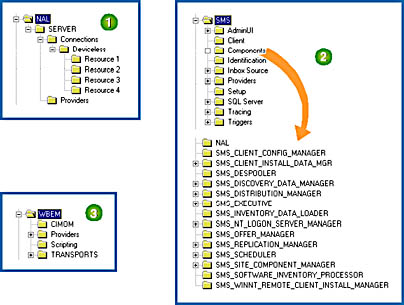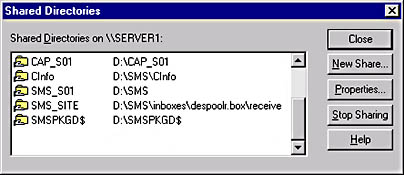Lesson 3: Changes to the Site Server
To fully grasp and troubleshoot a site server installation, it is important to understand what modifications were made to the Windows NT/2000 Server operating system as a result of an SMS site server installation. The SMS setup program creates an SMS Program Group, directory shares, and registry entries. In addition, services are installed and enabled during the installation process.
After this lesson, you will be able to
- List the function of the various icons in the SMS Program Group.
- Locate and explain the function of the SMS directory shares, registry entries, and Windows NT/2000 groups created on the site server.
- Describe basic functions of the SMS service and thread components installed on a site server, and manage the service and thread components with the SMS Service Manager.
SMS Icons
SMS setup creates the Systems Management Server program group on the site server. This group is not installed on secondary site servers because they are usually administered from their parent site. Figure 2-8 shows the icons installed in the SMS program group.

Figure 2-8. The SMS icons in the Systems Management Server program group.
- The SMS Administrator console (SMS.MSC)—This snap-in to the MMC is used to configure SMS. Files with the *.MSC extension launch the MMC to run the snap-in.
- SMS Administrator's Guide (SMSADMIN.CHM)—This is the online version of the SMS Administrator's Guide. Files with the extension *.CHM are compiled HTML files that are read by the HTML help engine, HH.EXE. Other *.CHM files for SMS are stored below the Windows NT/2000 operating system directory: \<winnt boot directory>\HELP\SMS\language ID\SMS.SRV\HTM. The language ID directory code is 00000409 for U.S. English.
- SMS Courier Sender (COURSEND.EXE)—The SMS Courier Sender is used to create, receive, confirm and view the status of parcels. Removable media can be used to store or receive parcels between sites. This feature allows site servers within a hierarchy that are connected by slow, unreliable WANs to share SMS package data. See Chapter 1 and Chapter 11, "Site-to-Site Communications" for more information on the SMS Courier Sender.
- SMS Release Notes (README.CHM)—The release notes contain important information that is not in any other documents or online help files published with SMS. There is also a README.HTM file, which can be viewed with any web browser.
- SMS setup (SETUP.EXE)—Provides modification options for the current SMS installation, including removing, modifying, or resetting the site server. New software components can only be installed from the SMS setup programs (AUTORUN.EXE and SETUP.EXE) on the SMS 2.0 installation CD-ROM rather than from the setup icon in the Systems Management Server program group.
- Network Monitor (NETMON.EXE)—This tool is used to collect, view, and analyze network frames (packets) as they traverse the network.
- Network Monitor Control Tool (MCSUI.EXE)—This tool augments Network Monitor by providing a method to continually monitor the network for unauthorized activity or other significant network events that could compromise the functioning of the network.
Internet Explorer 4.01 (or later) is required for the function of all *.CHM files. The SMS Administrator's Guide referred to throughout this guide provides more comprehensive details on SMS.
TIP
For easy access to all online help files, create shortcuts for all *.CHM files located in the \<winnt boot directory>\HELP\SMS\ language ID\ SMS.SRV\HTM directory.
SMS Registry, Share, Service, and SAM Database Additions
SMS setup makes configuration changes to the site server by adding registry, shares, services, and SAM database entries. These modifications are necessary to the operation of the site server. Understanding how the site server is modified will aid you in recovering a damaged site system.
SMS Registry Keys
As a result of an SMS installation, registry keys are added to store SMS configuration information. As changes are made, SMS updates the site control file and the registry keys where configuration changes are stored. The site control file will be discussed later in this lesson. Figure 2-9 shows some of the registry additions made by a site server installation on Windows NT Server version 4.0.

Figure 2-9. SMS registry entries.
The majority of the SMS configuration information is placed in four locations under the HKEY_LOCAL_MACHINE (HKLM) subtree.
- SOFTWARE\Microsoft\NAL holds client access point (CAP) access location information and fixed disk information that is used by the Client Install Data Manager. The Client Install Data Manager is a thread of the SMS Executive service that distributes software to CAPS for installation on client computers.
- SOFTWARE\Microsoft\SMS controls configuration data such as SMS setup and site information, SMS database locations, service configuration, and SMS specific SQL Server triggers. SMS maintains and updates this information through applications installed to support SMS, such as SMS setup and the SMS Administrator console.
- SOFTWARE\Microsoft\WBEM is used by all WBEM-enabled applications, such as the SMS Administrator console.
- SYSTEM\CurrentControlSet\Services contains the installed SMS services and their startup information. The operating system Service Control Manager and the SMS Service Manager maintains this information. The subkeys for SMS services are not shown in Figure 2-9.
NOTE
All SMS services use the Windows NT/2000 registry to look for configuration information. To prevent unauthorized users from changing information, the registry uses security permissions and the Windows NT/2000 user accounts database to grant or deny access. To prevent configuration changes from being made accidentally, use the secure Read Only Mode option when viewing the registry.
SMS Shares
SMS services and client agents use shares to communicate with site systems and for inter-site communications. Figure 2-10 shows the shares that are added by running custom setup to create a site server. The first and last shares listed in Figure 2-10 are commonly moved from the site server to other site systems serving the role of CAP and distribution point, respectively.

Figure 2-10. Shares created by SMS setup.
- CAP_site code exists on all CAP site systems and points to the \CAP_site code directory. For example, S01 is the site code for the installation of SMS completed through exercises in this chapter; therefore, the share name is CAP_S01. This directory is the main interface between the client computer and SMS. See Chapter 1 to review the purpose of the CAP.
- Cinfo is the installation share for the Seagate Crystal Info services. This share is located under the \SMS installation directory.
- SMS_site code points to the root of the SMS installation, with site code representing the name of the site. For example, S01 is the site code for the installation of SMS completed through exercises in this chapter; therefore, the share name is SMS_S01.
- SMS_SITE points to the \SMS\INBOXES\DESPOOLR.BOX\RECEIVE directory. This is the directory to which a remote site connects when transmitting data to the local site.
- SMS_PKGx$ is a hidden share created on the site server. The x in the share name is the drive letter with the most free space on the site server. This share supports site systems serving the distribution point role and is called the common package share.
Windows NT/2000 Users and Groups Created by SMS Setup
Three Windows NT/2000 users and two Windows NT/2000 groups are created by the installation of a primary site server.
- SMS Service account is named SMSService by default. The SMS Service account was discussed at length in Lesson 2.
- SMSClient_site code is used by client components to maintain CAPs and distribution points. For a site code of S01, the user account is SMSClient_S01.
- SMSServer_site code acts as a backup account if logon to the site server using the SMS Service account fails. This user account also provides site server access to various SMS services, such as retrieving inventory collection data from CAPs. For a site code of S01, this user account is SMSServer_S01.
- SMS Admins is a Windows NT local group containing the user account that installed SMS. Since you logged on as the Administrator to complete Exercise 5, the Administrator user is a member of the SMS Admins local group.
- SMSInternalCliGrp is a Windows NT/2000 global group used for SMS internal operations.
The SMS Admins local group is used for WBEM security. The SMS Administrator console connects to the site database through the WBEM/SMS Provider interface. The SMS Provider grants users who are members of the SMS Admins local group access to the database. WBEM user and group access can be configured using the WBEMUSER.EXE program installed in the \<winnt boot directory>\SYSTEM32\WBEM directory.
SMS Services
The SMS services are the heart of SMS functions. These services consist of processes and thread components that run in the background. The SMS services, which are synonymous with processes, appear in the Services application in Control Panel. The following SMS services are installed on a primary site server:
- SMS_EXECUTIVE manages over 40 individual thread components. These thread components are explored throughout this study guide. For a summary table of all thread components and their functions, see Appendix C, Table C.4, "Site System Thread Component Definitions" in the SMS Administrator's Guide.
- SMS_SITE_COMPONENT_MANAGER manages the installation and removal and state of process and thread components on all site systems.
- SMS_SQL_MONITOR monitors and maintains the site database and notifies related service and thread components of changes.
- Windows Management is used by the SMS Administrator console and other WBEM-compliant applications. This service will be installed by SMS if it hasn't already been installed by other WBEM-compliant applications. If this service is not running when the SMS Administrator console starts, the SMS Administrator console will automatically start it.
- Info Agent, Info APS, and Info Sentinel support Crystal Info. These services are discussed in Chapter 8, "Querying the Database and Producing Reports."
Background services that don't appear in the Service Manager are thread components of the SMS_EXECUTIVE service. To view both SMS services and thread components, select the SMS Service Manager node in the SMS Administrator console (found under the Tools node) and choose Start the SMS Service Manager from the Action menu. The SMS Service Manager application (Figure 2-11) allows the services to be controlled from any site system in the site hierarchy. The administrator can start, stop, pause, resume, and configure logging for any SMS process or thread component.

Figure 2-11. Services and thread components as seen from the SMS Service Manager.
EAN: 2147483647
Pages: 107